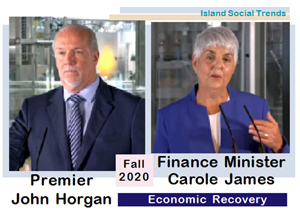
Thursday September 17, 2020 ~ VICTORIA, BC
by Mary P Brooke, editor | Island Social Trends
The $1.5 billion in economic recovery spending that has been earmarked for several months during the COVID-19 pandemic in BC was finally unveiled today by Premier John Horgan and Finance Minister Carole James.
A broad range of measures to stimulate economic recovery including the $1.5 billion recovery funding set aside in the Spring is defined in four categories: • Better health care • Getting people back to work • Helping businesses hire and grow • Supporting communities. That is further supported by provincial and federal restart investments for municipalities, transit and education
The plan outlines the latest steps the Government of British Columbia is taking to help people, businesses and communities recover and come out of COVID-19 stronger and better prepared. B.C.’s total provincial response to the COVID-19 pandemic exceeds $8.25 billion.
Continue adaptation:
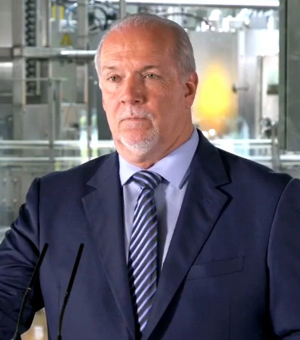
The COVID-19 pandemic has “faced not just our world, but the world,” said Premier Horgan in his opening remarks today. Saying there are ramifications for every corner of the planet, Horgan added: “The scale of the challenge was bigger than anyone could have imagined.”
Many of the expenditure initiatives have already been announced over the weeks and months of Phases 2 and 3 of economic recovery, including the hiring and training of more health care workers as well as the BC Emergency Benefit for Workers. These directions are strategic, with underlying goals to shift where jobs may be found in the workplace and recognizing it will take a protracted period of time to get there.
Short term and where economic recovery is headed:
The Economic Recovery Plan outlines where the Province has come from, what government is doing now, and some plans for the future:
•$9.6 billion in Covid-19 measures, of which $8.3 billion are provincial measures •$3.5 billion for critical services and financial supports •$1.5 billion for economic recovery spending measures •$660 million in new tax incentives for economic recovery •$1.862 billion for restart for municipalities, transit and education (including $810 million in provincial contribution) •$1.1 billion other Covid-related spending measures ($761 provincial) •$1.0 billion in foregone revenue and tax relief measures
Further supports for small business:
Over $1 billion in spending and tax measures are in place to build business confidence and support BC businesses, including:
- $300 million for the BC Small and Medium-sized Business Recovery Grant to provide one-time grants for eligible small businesses that have been hard-hit by COVID-19 (though it should be noted that some strenuous markers must be achieved, requiring some details proof of income loss);. and
- $660 million for business tax incentive measures:
>> Increased Employment Incentive ($190 million): A 15% tax credit on eligible new payroll to support businesses that increase their payroll from the third to fourth quarter of 2020. The credit is available to eligible businesses regardless of size, COVID’s impact on revenues or age of the business. (Note: this will only help businesses that will have the capacity to continue maintaining additional employees, going forward.)
>> Temporary PST rebate on select machinery and equipment ($470 million): 100% PST rebate to help eligible businesses make the kinds of investments that will help them adapt to a post-COVID economy. (Note: historically, this sort of offering has helped certain sectors and not others.)
Tourism sector:
On the surface, it appears that direct financial support to the tourism sector is lower than what the industry had been asking for. But combined with small/medium business supports (as above) and an additional 10 percent top-up for tourism businesses (details to come), the support is there for businesses that have a viable plan going forward.
There is however, possible evidence of the NDP government’s strategy to get more workers into other sectors like health care where there is the distinct possibility of significant job shortages (such as workers in long-term care and home care).

A further NDP strategy is to try and provide more secure career-style employment to women and others who have been caught in the low-income trap that has prevailed in the seasonal tourism industry (which over the years has contributed to the prevalence of precarious work overall, and contributing to non-livable wage levels for employees that the businesses would hope to attract).
Finance Minister Carole James explained that the tourism economic recovery task force has its own $50 million fund that can be spent on initial recommendations that can be utilized immediately: $19 million for small municipalities to adapt and diversify; $14 million for tourism initiatives; and $20 million for tourism infrastructure projects. “It’s a perfect time for some communities to renew some amenities and some infrastructure,: said James.
Tourism businesses are also eligible for the small and medium size business loan program ($300 million fund), within which tourism businesses may receive an additional $10,000 as part of their grant program to support as well.
Strengthening food security:
While this NDP government has been strong on attention to the agriculture sector all along, this economic recovery plan includes a distinct section on Food Security and Resiliency.
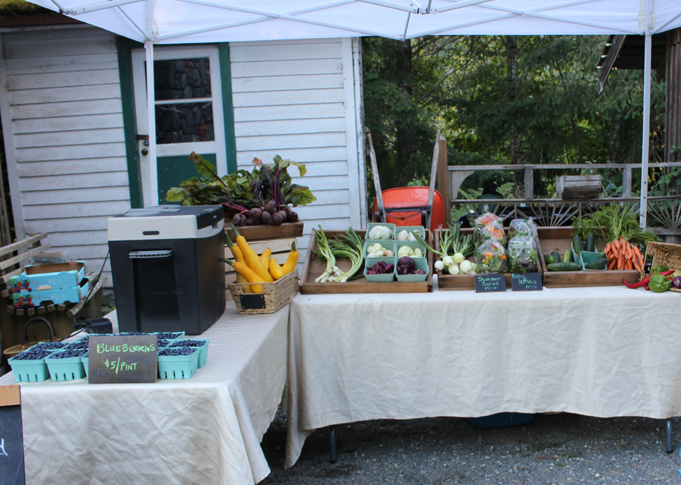
And while that section includes a component directed at PPE manufacture (that could largely be seen as pivoting alcohol producers over to hand sanitizer production), the new bigger picture includes targeted investments in the development of local food systems including helping out small and new farmers with business supports.
This is mid-to-long term planning for food resiliency, particularly on Vancouver Island where disruption of transportation networks (for any number of reasons, including a major earthquake) could seriously impact the availability of food for an extended period.
Today Premier Horgan said that part of keeping BC running is attention to “the supply chain for putting food on the table”. Action on this cognizance is yet another indicator of how long the pandemic may last.
In fact, today both Provincial Health Officer Dr Bonnie Henry and Health Minister Adrian Dix repeated (in their 3 pm media teleconference) that the pandemic will effectively go on for years.
Gig and home-based business needs:

There is pretty much no mention of the gig economy and home-based business, which by default are perhaps still seen by economic planners as temporal or fringe ways to earn a living.
Recognizing the lifestyle components of those ways to make a living as being desirable to people in various life circumstances may be absent in a plan that is, granted, undertaking the herculean task of reshaping an entire economy over years and decades. But not leaving those sectors behind would be wise and inclusive.
Municipalities and infrastructure:
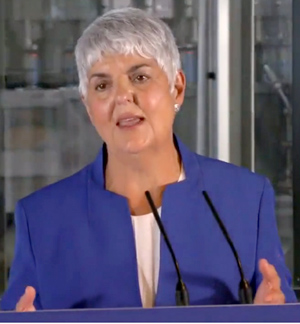
Municipalities that have shovel-ready projects for infrastructure are favoured in this economic recovery plan. Small towns that rely on tourism will also have access to funds for adapting their local economies.
Minister James said today that many thousands of jobs have been lost in the construction sector. That’s despite the industry continuing to operate during the pandemic.
The Government of Canada and the Province of British Columbia are working together to contribute close to $540 million in funding to support local government operations. Today’s announcement also includes details on an additional $418 million for community infrastructure, along with $1 billion in provincial and federal investments to help keep people moving, whether by transit, TransLink or BC Ferries.

This funding is provided as part of the Canada-BC Safe Restart Agreement and will be allocated as follows, according to the Union of BC Municipalities (UBCM):
- $425 million for local governments – to address local government facility reopening and operating costs, emergency response costs, lost revenues and other COVID-related impacts;
- $100 million for strengthening communities – to support local governments in addressing the needs of vulnerable populations, the challenges posed in local communities by homelessness, and community concerns with street disorder and safety; and
- $15 million for development services – to continue the work identified through the Development Approvals Process Review (DAPR) and support innovative local government efforts to improve the efficiency of development approval processes.
The funding streams for Development Services and Strengthening Communities will be application-based. All local governments will be eligible to apply, and further details about the application process and eligible costs will be provided this fall.
Today’s announcement also includes details on the following:
- An additional $418 million to revitalize community infrastructure, enhance connections between communities and get people back to work. Within this stream, $100 million in infrastructure grants for shovel-ready projects in a new Community Economic Recovery Infrastructure Program.
Retail during the pandemic:
People have consistently spent less on clothing and gasoline for their vehicles during the pandemic; this reflects how much more time people are spending at home for employment, taking care of children, or dealing with illness in self-isolation.
All other areas of consumer spending have rebounded to near or beyond pre-COVID levels. Minister James said that is largely due to people being supported by government pandemic funding such as the Canada Emergency Response Benefit (CERB) and BC’s increased amounts to people with disabilities as well as the one-time BC Emergency Worker Benefit.
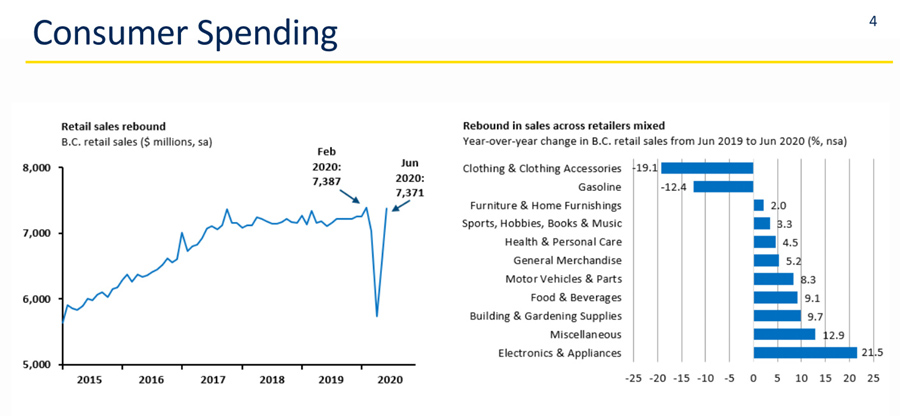
Comments starting to roll in:
“This plan is a good starting place and includes many important initiatives to get British Columbians through this pandemic,” said B.C. Green Party leader Sonia Furstenau and MLA for Cowichan Valley. “However, there is more work to do to connect these short-term supports with a long-term sustainable recovery plan.”
The Association of Mineral Exploration (AME) says it welcomes the Economic Recovery Plan released today by Premier John Horgan and Finance Minister Carole James. “AME recognizes the importance of the short-term measures put in place to stimulate economic recovery in all regions of the province,” said AME President and CEO Kendra Johnston.




